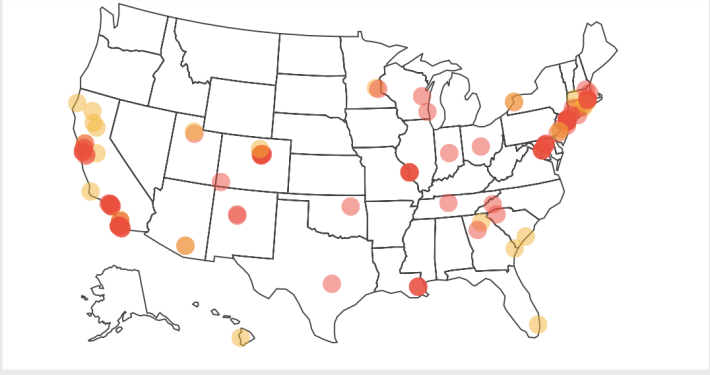Charter schools are diverse by design? Holy sampling on the dependent variable Batman! All Major League Baseball (MLB), National Basketball Association (NBA) and National Football League (NFL) teams are good because look at the top of the standings! All music is great because look at the Top 40 songs! All college professors are great (or could be) because of the top 2.19% on ratemyprofessor.com
The Century Foundation recently release a report about “Diverse-by-Design Charter Schools.” by Halley Potter and Kimberly Quick

They found,
- Intentionally diverse charter schools represent a small slice of the charter sector (about 2 percent of the charter schools examined for this report)
- The inventory identifies broader trends related to diversity in the charter sector. One in five charter schools (1,026 schools) showed any consideration of diversity in their school model.
- School integration has not been a priority for the charter school sector at large. At the same time, the schools highlighted in the report show how the flexibility of the charter school model can be leveraged for diversity if designed to do so.
So, all NFL, NBA and MLB teams can be great, but they are not. All professors could be fantastic, but only 2% are? Despite all this bad news, they still conclude,
The schools highlighted in the report show how the flexibility of the charter school model can be leveraged to promote diversity. Though a small fraction of the charter school sector, the number of diverse-by-design charter schools is growing. These schools provide a variety of models and strategies for integration that could help other schools—charter, district, or magnet—seeking to enroll and serve diverse groups of students.
Am I the only person saying “Who cares, why are you wasting my time?” Wait… for… it… “This case study is part of The Century Foundation’s project on charter school diversity, funded by The Walton Family Foundation.”
I asked my doctoral student (Miguel Sanchez) to take a look at the report and answer four questions.
1) How many were diverse out of total?
Only 125 out of the 5,692 charter schools that were reviewed met the definition of intentionally diverse (Table 1, p.6). Only 2.19% of the schools used in this case study have expressed a minimum commitment to diversity as part of their strategy to close the equity gap. Likewise, only 2.19% of the charter schools in this study have publicized a strong commitment to diversity; the other 97.81% of schools did not promote, encourage, and welcome through their social media venues the diversity that can reflect a proportional representation of the local school’s demographics.
2) Did they only look at websites?
This case study used “complete website review for 6,281 schools.” (p. 4). Also, this case study used “contact information and send this survey to 971 schools, offering schools a small monetary reward for answering the survey. They received 86 survey responses” (p.4). In addition, this case study “also looked at the membership of the Diverse Charter Schools Coalition (DCSC) as an indication of commitment to diversity” (p.4).
3) How diverse were the campuses relative to nearby schools?
This case did not compare the 6,281 charter school campuses to nearby traditional public schools to determine if the diversity was similar to the proportionally represented nearby public schools.
4) Does diverse mean concentration?
In this case study, diverse doesn’t mean concentration. In fact, the school’s commitment to diversity was judged as strong if it met one of the following criteria: the school’s website had to receive a high score on their commitment to diversity (p.10). Second, their charter school’s survey response showed a high level of commitment to diversity through their use of enrollment and recruitment strategies to achieve a racially or economically diverse student body; and the school’s website had at least a medium score for commitment (p.10). Third, the charter school is a member of the Diverse Charter Schools Coalition (p.10).
Just in case you want to know where the 125 of 5,692 diverse charter schools are, here you go.

Have you ever had a disagreement with someone and when they present their evidence for their argument and it actually makes the case for what you are trying to communicate to them (See With Charter Schools, A Step Back to Segregation) then they don’t even realize it?
Please Facebook Like, Tweet, etc below and/or reblog to share this discussion with others.
Check out and follow my YouTube channel here.
Twitter: @ProfessorJVH
Click here for Vitae.

I cannot wrap my head around why you would include the Red Bank Charter School as an example of a charter school that is “intentionally diverse” or “diverse by design.”This is a charter school that, in the words of its trustee president, was started to “mitigate the effects of white flight” from Red Bank, a 1.7-square-mile town in NJ. And because of this charter school, Red Bank is home to the most segregated publicly funded schools in the state of NJ. Consider this: In Red Bank, 43% of the charter school students are white, while 8% of the district public school students are white. 44% of the charter school students are Hispanic, while 79% of the district public school students are Hispanic.
And compared to all other school districts in New Jersey, Red Bank has the widest gap between charter and district schools when it comes to the percentage of limited English proficient (LEP) students. Red Bank charter is only 5% LEP, while the district public schools are 35% LEP. And 38% of charter students qualify for free-and-reduced lunches compared with 89% at the district public schools. That last statistic is particularly important when you consider that the Red Bank Charter School implemented a weighted lottery three years ago in an effort to increase the number of poor students who attend the school. Instead the percentage has fallen from 41% to 38%.
So tell me, again, how is this school “intentionally diverse” if it was formed to attract white families, if its demographics are so dramatically different from its host district that it has caused that district to be the most segregated in New Jersey, and if its effort to increase the number and percentage of poor students has failed?
http://www.fairschoolsredbank.org/
LikeLiked by 1 person
Red Bank charter is one of the most segregated charters in the state of NJ especially when comparing it to the home district.
It would be great to see a study comparing home district to charter district by poverty and specific disabilities.
LikeLiked by 1 person
Bob,
Is this what you are looking for?
https://rucore.libraries.rutgers.edu/rutgers-lib/56004/PDF/1/play/
and
Click to access NJ-Charter-School-Report-Part1.pdf
LikeLike
How about ‘segregated by design’ – like in Minnesota
http://www.edhivemn.com/story.php?storyID=4
LikeLiked by 1 person
Not “diverse by design”? Or, “not diverse by design”?
LikeLike
Yes
LikeLiked by 1 person
My response is that if only 86 charter schools responded to a survey about diversity it’s unlikely that even 125 care about it.
LikeLike
Have you ever had a disagreement with someone and when they present their evidence for their argument and it actually makes the case for what you are trying to communicate to them (See With Charter Schools, A Step Back to Segregation) and they don’t even realize it?
This reminds me of the quote from Mark Twain that my grandfather would always say to me:
“Never argue with a fool, onlookers may not be able to tell the difference.”
So when looking at the argument presented by Charter Schools, they definitely think that everyone does not possess the intellectual capacity that they have.
So, perhaps arguing with them does show their lack of care for students of color.
LikeLike